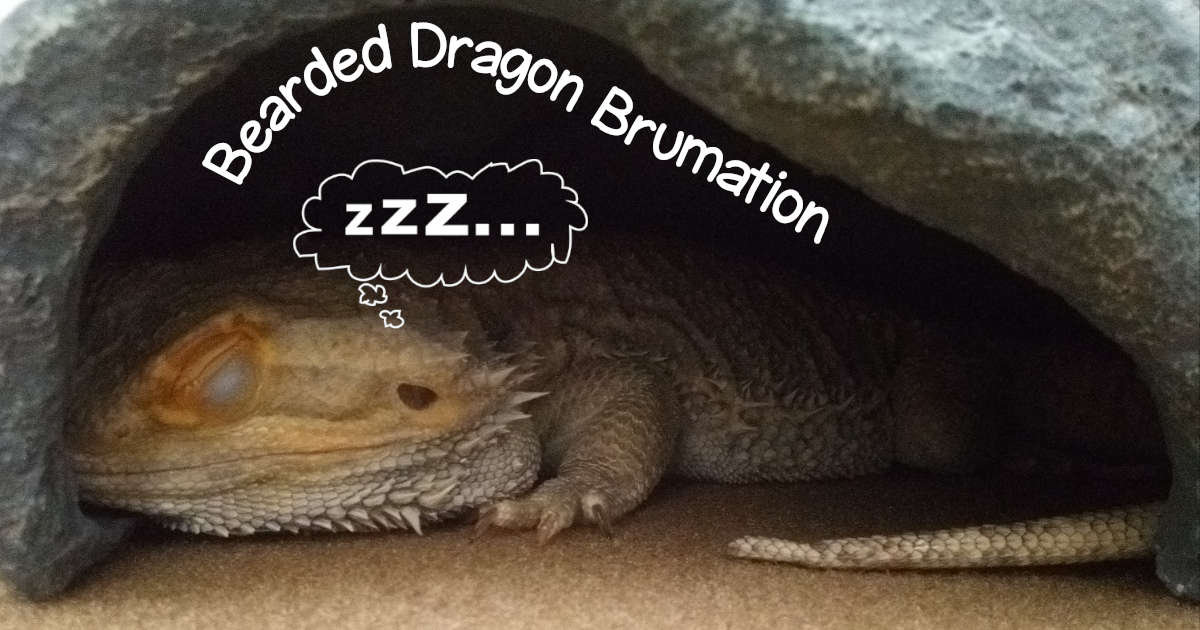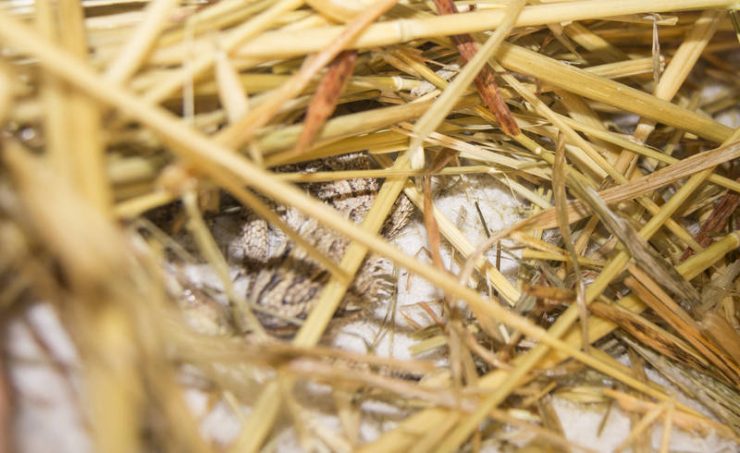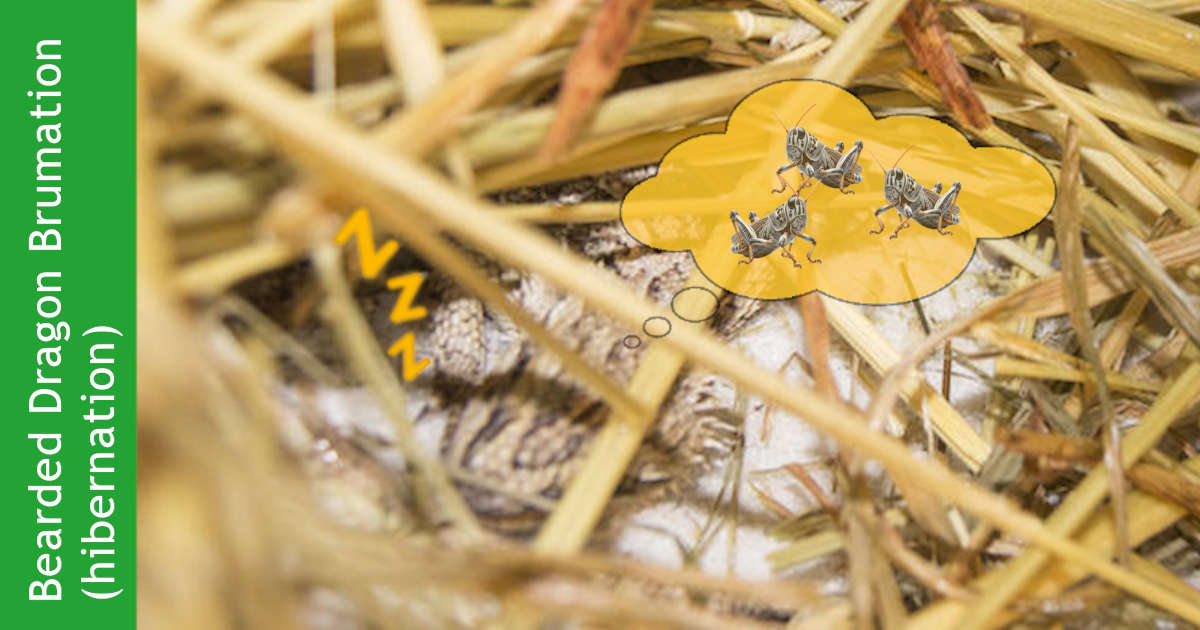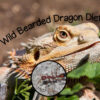
Bearded dragon brumation, a period of dormancy similar to hibernation in mammals, is a fascinating and vital aspect of these reptiles’ life cycle. This natural process, often observed in cooler months, involves significant changes in behavior and physiology.
Understanding brumation is essential for any bearded dragon owner, as it affects the care requirements of these pets and provides insights into their health and well-being.
Jump To…
Brumation Explained
What is Bearded Dragon Brumation?
Bearded dragon brumation is a natural phenomenon that occurs in reptiles, particularly this species of lizard, during the colder months of the year. Brumation is often referred to as reptile hibernation, but there are some notable differences between the two processes. Both brumation and hibernation involve a decrease in an animal’s metabolism and a period of dormancy, but brumation is a more controlled and unique process specific to reptiles like bearded dragons.
While in brumation, bearded dragons, or Pogona vitticeps, enter a sleep-like state, conserving energy and reducing their overall activity. During this time, they may eat less, drink less, and sleep more to adjust to the changing temperatures and seasonal conditions.
What is the Difference Between a Bearded Dragon Sleeping and Brumating?
The difference between a bearded dragon sleeping and brumating lies primarily in the duration and behavioral patterns exhibited.
Sleeping: This is a daily activity where the bearded dragon rests for a period, usually at night. They wake up with the return of light and warmth, resuming their normal activities like eating and basking.
Brumating: Brumation is a prolonged period of dormancy that can last for weeks or even months, typically occurring in cooler seasons. During brumation, bearded dragons become very lethargic, eat very little or nothing at all, and may bury themselves in their substrate. Unlike regular sleep, brumation involves a significant reduction in metabolic activity and is a response to environmental changes, not just a daily need for rest.
Why do Bearded Dragons Brumate?
Bearded dragon brumation is a natural process that allows these reptiles to save energy during winter months when resources are scarce. In the wild, a bearded dragon’s instinct tells it to find a safe, secluded spot to spend the winter months. The temperature drops, causing a decrease in metabolic processes and a reduction in the need for food.
During brumation, bearded dragons exhibit a significant decrease in metabolic rate, a crucial adaptation for enduring periods when food is scarce and temperatures drop below levels conducive to their normal physiological processes (Zimmerman, Vogel, & Bowden, 2010).
This period of dormancy, sometimes referred to as “bearded dragon hibernation,” serves as a survival strategy in response to environmental changes, particularly fluctuations in temperature and daylight.
The primary purpose of “bearded dragon brumation” is to conserve energy during times when their natural habitat becomes inhospitable. In the wild, the onset of colder temperatures, diminished food availability and shorter days (bearded dragons third eye) triggers this state of reduced activity.
As ectothermic creatures, bearded dragons rely on external heat sources to regulate their body temperature. With the fall in ambient temperatures, their bodies enter a state of slowed metabolic activity, thereby reducing the need for frequent feeding and activity, an adaptation that is crucial for their survival during the colder months (Zimmerman et al., 2010).
Another significant aspect of “bearded dragon brumation” is its role in the reptiles’ reproductive health. Brumation helps in regulating reproductive cycles, preparing bearded dragons for breeding season following their emergence from this dormant state. However, bearded dragons can breed without first brumating.
What is the Difference Between Brumation and Hibernation
While bearded dragon hibernation is a term sometimes used, it is less accurate compared to brumation. Hibernation typically refers to a state of deep sleep in mammals, whereas brumation is a less intense form of dormancy adapted to the unique physiological needs of ectothermic reptiles like bearded dragons.
Bearded dragon brumation differs from hibernation, though they share the purpose of energy conservation. Research on the Australian central bearded dragon (Pogona vitticeps) provides insights into these states.
A study by Capraro et al. (2020) explored microRNA dynamics during bearded dragon hibernation, revealing the role of miRNAs in modulating cellular metabolism and neuroprotection in the brain during this state (Capraro et al., 2020). Another study by the same team (Capraro et al., 2019) examined gene expression and proteomic changes during bearded dragon brumation, highlighting the induction of stress response pathways and protective mechanisms in various tissues, including the brain, heart, and skeletal muscle (Capraro et al., 2019).
These studies underscore the complexity of physiological adaptations in bearded dragon brumation / hibernation. While both are survival strategies, bearded dragon brumation is a more common and less intense form of dormancy compared to bearded dragon hibernation, reflecting their evolutionary and environmental adaptations.
When Will My Bearded Dragon Brumate?
In captivity, bearded dragons still feel the instinct to brumate. However, it can only occur properly if they are given an environment that to some degree replicates the natural environmental temperatures that they would normally experience in winter. This can be done by gradually adjusting the temperature and lighting conditions in the enclosure to mimic the change of seasons.
What Will Happen If I Don’t Provide The Right Conditions for Brumation?
Bearded dragons may still pick up on environmental cues even if not provided the right conditions to brumate. They may detect the days shortening in winter, especially if they are placed near a window. They may also detect a change in the temperature, especially if they are let out of their enclosure where temperatures and lighting are set.
Without the right conditions bearded dragon brumation will not occur properly. This could result in the reptile acting completely normal or entering short periods of dormancy, being sluggish, not overly interested in eating but never really going into a deep sleep.
Insufficient temperature changes or inadequate hiding spots, may lead to the bearded dragon being stress and illness.
What are the Risks of Brumation?
While “bearded dragon brumation” is a critical aspect of their life cycle, it requires careful management, especially in captivity, to avoid potential complications.
One of the primary risks during “bearded dragon brumation” is the possibility of health complications arising from improper conditions. A study on tortoises and turtles highlighted the importance of clinical health checks, including blood testing before brumation, to reduce the risk of complications (Leineweber et al., 2021). These checks are crucial in identifying any underlying health issues that could be exacerbated during the brumation period.
Another study on the smooth green snake discussed the trade-offs related to temperature response post-release when reptiles are kept active instead of undergoing brumation (Sacerdote-Velat et al., 2014). This indicates that skipping the brumation process can impact the reptile’s normal physiological functions, suggesting that brumation is an integral part of their life cycle.
Other factors that impact the safety of bearded dragon brumation include their current load of parasites or environmental factors, such as the temperature and humidity of the brumation environment. Inadequate conditions can lead to stress, illness, or in extreme cases, death.
It’s essential to replicate natural brumation conditions as closely as possible to minimize these risks. In addition, regular health checks, proper environmental conditions, and a thorough understanding of the brumation process are key to ensuring the safety and well-being of bearded dragons during this period.
How Long do Bearded Dragons Hibernate for?
The duration of brumation can vary depending on the individual bearded dragon, environmental conditions, and age. Typically, brumation in bearded dragons lasts anywhere from a few weeks to several months.
During this time, they may spend more time hiding and show less interest in their surroundings. The end of the brumation period is similarly gradual, as they slowly return to their normal levels of activity and appetite.
In summary, “bearded dragon brumation” can vary in length, and is aligned with the colder months of the year. The duration and intensity of brumation can be influenced by both natural and captive environmental conditions.
What Months do Bearded Dragons Brumate?
Bearded dragon brumation, a period of dormancy similar to hibernation, is influenced by environmental cues, particularly changes in temperature and daylight hours.
As pets, the timing of the brumation period varies depending on the hemisphere in which they reside.
In the southern hemisphere, such as in Australia where bearded dragons are native, winter occurs from June to August. During these months, the cooler temperatures and shorter days trigger bearded dragon brumation. This period allows them to conserve energy at a time when food is less available and temperatures are not ideal for their regular activities.
Conversely, in the northern hemisphere, including countries like Canada, Ireland, Germany, the USA, and the United Kingdom, winter spans from December to February. Bearded dragons in these regions would typically enter brumation during these months, aligning with the local climatic conditions.
Factors such as temperature regulation, lighting, and food availability in captivity can influence whether and when a bearded dragon will brumate.
Signs a Bearded Dragon is Going into Brumation
Recognizing the signs of bearded dragon brumation is part of ensuring the health and well-being of these reptiles. Bearded dragons exhibit a range of behaviors prior to entering brumation, which are important indicators for their owners. Common signs of bearded dragons preparing for brumation are:
- Decreased Appetite & less bowel movements: Bearded dragons may show reduced interest in food or eat less frequently, subsequently they will poop less. This change in eating habits is a natural part of their preparation for a period of dormancy.
- Lethargy: A noticeable decrease in activity. Bearded dragons might become less active during the day, spending more time resting or sleeping.
- Burying or Hiding: Seeking out secluded spots is typical behavior. Bearded dragons often burrow in their substrate or hide in their enclosure as they prepare for brumation. Let them burry themselves or hide, this is normal.
Is my Bearded Dragon Dead or Brumating?
Sometimes pet owners are concerned their bearded dragon has died instead of brumating. During bearded dragon brumation they will usually be on the cool side of their cage and likely to be hiding in or under objects to exclude themselves from the world.
Bearded dragons will occasionally move or shift positions. Their bodies will remain pliable and not stiff, and they will continue to breathe, albeit at a slower rate. A bearded dragon that has died will not be pliable, but stiff nor can it shift any limbs.
Bearded dragon brumation is akin to a very deep sleep. Bearded dragons eyes will be shut during brumation. If the reptile is still, as if it were in brumation and its eyes are open, it is unlikely to be brumating.
If in doubt, it is always advisable to consult a veterinarian experienced in reptile care.
What Happens to Bearded Dragon Femoral Pores During Brumation
When bearded dragons enter brumation the activity of their femoral pores noticeably decreases. During this rest phase, the femoral pores slow down much like the rest of their functions.
Inducing and Preventing Brumation
Bearded dragon brumation can be encourage by providing winter conditions. Conversely you can get your bearded dragon out of brumation or prevent it all together.
What Age do Bearded Dragons Brumate?
Ideally a bearded dragon will not brumate before it reaches 10 months old. Bearded dragons need to be able to store some fat to take them over a brumation period. If a bearded dragon tries to brumate too young look at your temperatures, lighting and any cues it may be picking up on to tell it that it is winter. That could be as simple as they can see the light from a window in the house. If unsure on whether your bearded dragon is ready for brumation, ring your vet.
How to Get Your Bearded Dragon to Brumate
Inducing bearded dragon brumation in captivity requires mimicking their natural environmental conditions to trigger this hibernation-like state. The key is to gradually adjust the lighting and temperature in their habitat to simulate the winter conditions they would experience in the wild.
Starting late autumn or early winter, gradually reduce the temperature in their habitat by a few degrees for a few weeks until you reach the optimal brumation temperature range of 16–21°C (60–75°F). At the same time shorten the daily light cycle to 10 hours (Strimple and Strimple, 1998; Stahl, 1999).
At the same time, g
This gradual change in light and temperature closely resembles the seasonal shift that bearded dragons would naturally experience, signaling to their bodies that it’s time to enter a state of brumation.
Researchers Cadena, Rankin, Smith, Endler, & Stuart-Fox (2017) were conducting research on how temperature induced color changes vary with season. During this research they successfully put their subjects to sleep by modifying their enclosure conditions to resemble their native winter environment.
Over a three-week period, they methodically lowered the room temperature to 13 °C, shortened the lighting duration, and gradually reduced their food intake until it was completely stopped. Within a week of these changes, all lizards had begun brumation, which lasted from early June to late July.
How do I get my Bearded Dragon out of Brumation?
Getting a bearded dragon out of brumation or preventing it altogether requires understanding and manipulating their environmental cues. Bearded dragons enter brumation in response to changes in light and temperature, which mimic the natural approach of winter. Even if they are kept in summer-like conditions inside their enclosure, exposure to natural light from a window can influence their internal rhythms, signaling to them that it’s time for brumation.
To Prevent Bearded Dragon Brumation:
- Control Light Exposure: Ensure that your bearded dragon’s enclosure is not influenced by the natural light changes from outside, especially if it’s near a window. Use artificial lighting to maintain consistent light patterns that mimic summer, with longer daylight hours.
- Maintain Warm Temperatures: Keep the temperature inside the enclosure consistently warm, similar to summer conditions in their natural habitat. The cooler area of the enclosure should be set to the temperatures recommended for summer.
- Monitor Feeding and Activity: Maintain a regular feeding schedule and ensure your bearded dragon remains active. A decrease in appetite and activity can be preludes to brumation.
Ending Bearded Dragon Brumation:
- Gradually Increase Light and Heat: Slowly increase the hours of light and the temperature in the enclosure to simulate the coming of spring over a few weeks.
- Encourage Activity: Once you start changing the environment, gently encourage your bearded dragon to become more active. You can do this by interacting with them more frequently and offering food.
- Consult a Veterinarian: If you’re trying to bring a bearded dragon out of brumation for health reasons or if they’re not responding to environmental changes, consult a veterinarian for guidance.
Remember, brumation is a natural process for bearded dragons, and in many cases, it’s best to allow them to go through this cycle, especially if they are healthy. However, if brumation poses a health risk, or if you have specific reasons for wanting to prevent or end it, modifying their environment is key. Always monitor their health closely during these changes and consult with a reptile-savvy veterinarian if you have any concerns.
As discussed in the section “How to get your Bearded Dragon to Brumate” above, researchers Cadena, et al (2017) were conducting research on how temperature induced color changes vary with season. Having put their subjects into brumation they later proceeded to wake them out of brumation. The temperatures and lighting were gradulally restored to their original state. In turn the bearded dragons quickly returned to their usual eating patterns and exhibiting normal thermoregulatory and social behaviors.
Having come out of brumation, all males displayed typical courtship behaviors, such as head bobbing and beard darkening, when introduced to female bearded dragons, who were not part of the study.
How to Care for a Bearded Dragon Before & During Brumation
Pre Brumation Health Assessment
To safely enable bearded dragon brumation it is important to perform a thorough health assessment to address any potential health concerns. This assessment typically involves:
- Observe behavior and appearance: Ensure the bearded dragon’s overall demeanor and physical condition are consistent with a healthy state.
- Check for weight loss: An unhealthy amount of weight loss prior to or during brumation may signal underlying health problems.
- Monitor bowel movements: Keeping track of their bowel movements will help identify any digestive issues that need to be addressed before brumation.
- Vet check: Have a pre brumation vet check completed. Vets will look at their overall health, and parasite load. This will help provide peace of mind during brumation.
Taking these steps can help ensure that your bearded dragon is in good health and ready to enter brumation successfully.
Preparation of Habitat
Provide your bearded dragon with a comfortable and secure area to rest. Make sure their enclosure is clean and free from any debris or waste. Add extra hiding spots using caves, logs, or large rocks to create more privacy during this time.
The enclosure should be clean reducing the spread of pathogens and parasites.
Adding a substrate that’s comfortable in your bearded dragon burrow or hide, such as hay or coconut fiber will help with allowing it to hide away. This mimics their natural environment and allows them to burrow for additional warmth and security during brumation.

Feeding Before Brumation
Bearded dragon brumation naturally reduces their appetite and their digestive processes naturally slow down. It’s crucial to adjust their feeding schedule accordingly to ensure they are not entering brumation with undigested food in their stomach, which could lead to health complications.
In the weeks leading up to brumation, you may notice a gradual decrease in your bearded dragon’s appetite. This is a natural response to the changing conditions and an indication that their body is preparing for brumation. During this time, it’s important to offer food, but also to pay attention to their appetite and reduce the quantity if they are eating less.
About 1 to 2 weeks before brumation is expected to start, stop feeding. This period allows them to fully digest any remaining food in their system. Continue to offer water during this time is important, as hydration remains crucial.
Once in brumation, bearded dragons will not eat and their digestive system essentially shuts down. If you are unsure about when to stop feeding or have concerns about your bearded dragon’s health, consulting with a veterinarian experienced in reptile care is advisable.
Providing Water During Brumation & how to Check if its Needed
Hydration plays a crucial role in the health of bearded dragons. During bearded dragon brumation their need for water, although reduced, remains essential. Here’s how you can ensure your bearded dragon stays properly hydrated during this period.
- Monitoring Humidity Levels: Use a digital hygrometer to monitor the humidity inside the enclosure. Bearded dragons require a specific humidity range for optimal health, and this becomes even more important during brumation.
- Misting of the Enclosure: If the humidity levels are low, mist the enclosure.
- Providing a Shallow Water Bowl: Keep a shallow bowl of fresh water in the enclosure. While some bearded dragons may not drink from still water, it’s important to have it available. The bowl should be shallow to prevent any risk of drowning.
- Adjusting Watering Frequency: Be mindful of your bearded dragon’s reduced need for water during brumation. Overwatering can be as harmful as dehydration. Adjust the frequency of misting and soaking based on their behavior and the enclosure’s humidity.
- Checking for Dehydration: Periodically check for signs of dehydration, such as sunken eyes or wrinkled skin.
Should I Bathe my Bearded Dragon During Brumation?
Bathing a bearded dragon during brumation is generally not recommended. Brumation is a period of dormancy similar to hibernation, during which bearded dragons significantly reduce their physical activities and metabolic processes. Disturbing them with baths can disrupt this natural cycle.
During brumation, bearded dragons often do not eat and their digestion slows down considerably. They also tend to conserve energy and may not move much. Bathing them during this time can be stressful as it forces them to expend energy and regulate their body temperature, which they are conserving for the brumation period.
However, hydration remains important. Instead of bathing, you can gently mist their enclosure to maintain humidity, or provide a shallow water dish in case they do become active and need to drink. If you notice signs of dehydration, such as sunken eyes or wrinkled skin, consult a veterinarian experienced in reptile care for advice.
Should I Feed my Bearded Dragon During Brumation?
Bearded dragon do not require feeding during brumation. Bearded dragon brumation is a period of dormancy similar to hibernation, during which they significantly slow down their metabolic processes. Their digestive system becomes less active, and they do not require regular feeding.
Feeding a bearded dragon during brumation can be harmful because their reduced metabolic rate means they are unable to digest food properly. This can lead to digestive complications and health issues. It’s important to ensure that your bearded dragon has completely emptied its stomach before entering brumation. This is typically achieved by ceasing feeding one to two weeks prior to the expected start of brumation, allowing any remaining food in their system to be fully digested.
Should I Wake My Bearded Dragon During Brumation
It’s best to avoid interrupting the bearded dragon brumation cycle, as this can lead to stress and potential health issues. However, in some cases, it may be necessary to wake them up temporarily for essential care. In these instances, gently warm your pet up and give them time to adjust before returning them to their brumating state.
How to Care for a Bearded Dragon After Brumation
Waking Up and Re-energizing
After their brumation period has ended, bearded dragons gradually wake up and become more active. The process can take several days to a week. Their metabolism starts to increase, and as a result, their energy levels rise as well. During this time they may have a lower appetite than usual but will slowly regain their normal hunger levels as their body adjusts.
To help your bearded dragon re-energize after brumation, ensure they have access to:
Assessing Health Post-Brumation
Post-brumation is an important time to assess your bearded dragon’s health and check for any potential issues that may have arisen during their hibernation. Some common health concerns to look out for include:
- Weight loss: It’s normal for bearded dragons to lose some weight during brumation, but excessive weight loss (over 10% of their body weight) may need attention from a veterinarian (Chang, Li, Hall, Eden, Hyndman, Holmes, & Rose. 2020)).
- Bowel movements: As their metabolism increases, bearded dragons should start having regular bowel movements again. If they don’t, consult a veterinarian to rule out any potential health issues.
- Behavioral changes: Monitor your dragon closely for any drastic behavioral changes such as lethargy, aggression, or appetite loss, as these could be signs of an underlying health problem. It is not uncommon for a bearded dragon, particularly males, to become aggressive after brumation as hormones for mating season kick in.
Readjusting to Normal Routine
Once your bearded dragon starts to regain their usual energy levels and appetite, work on reintroducing them to their normal routine. This includes feeding them their regular diet, resuming routine basking times, and facilitating opportunities for exercise and mental stimulation. It’s important to make this transition as smooth as possible to help your dragon readjust to their pre-brumation life with ease.
Keep in mind that each bearded dragon is unique, and the time it takes to fully recover and readjust from brumation will vary. Always monitor your bearded dragon’s behavior and consult with a reptile veterinarian if any concerns arise.
Conclusion
Bearded dragon brumation is part of providing a natural experience in captivity. Brumation, which can be considered as the reptile version of hibernation, is a natural process that allows them to conserve energy during colder months when resources are limited. This comprehensive guide provides valuable insights into the behavior, biology, and adaptive strategies that bearded dragons employ during brumation.
Studies on bearded dragons have shown a complex array of molecular mechanisms that they use during brumation to regulate their metabolism, conserve energy, and survive without food or water for extended periods. Although many similarities exist between mammalian hibernation and reptile brumation, it is essential to remember that they are separate processes unique to each animal group.
To better care for a brumating bearded dragon, it is crucial to closely monitor their behavior, body temperature, and health. Providing a proper environment, including a cooler, darker, and safe spot, will help support a successful brumation period for the reptile. Also, being aware of potential health complications, such as hepatic lipidosis, during brumation assist to detect any issues early and provide appropriate care.
In conclusion, understanding bearded dragon brumation is part of being a responsible reptile pet owner.
Frequently Asked Questions
Do bearded dragons brumate or hibernate?
Bearded dragons primarily undergo brumation, a dormancy similar to hibernation, in response to cold temperatures and limited food. During brumation, they show reduced metabolic rates and activity, conserving energy when resources are scarce. Unlike hibernation, which involves deeper dormancy and is less common in bearded dragons, brumation is a milder form of dormancy more suited to their natural behavior and environmental needs. Studies on bearded dragons highlight these adaptations, emphasizing brumation as their typical response to seasonal changes.
Should I feed my Bearded Dragon during brumation?
No, you should not feed your bearded dragon during brumation. During this period, their metabolism significantly slows down, and their digestive system becomes less active. Feeding them during brumation can be harmful as they are unable to properly digest food, which could lead to health complications. It’s important to ensure that your bearded dragon has completely emptied its stomach before entering brumation. This is typically achieved by ceasing feeding one to two weeks prior to the expected start of brumation, allowing any remaining food in their system to be fully digested. However, you should continue to provide fresh water to ensure they stay hydrated. If you have any concerns about your bearded dragon’s health during brumation, it’s advisable to consult with a veterinarian experienced in reptile care.
How long do Bearded Dragon’s brumate for?
The duration of brumation can vary for each bearded dragon. Generally, it can last anywhere from a few weeks to several months. Factors such as the individual dragon’s age, overall health, and environmental conditions can influence the exact duration of brumation.
References
- Capraro, A., O’Meally, D., Waters, S., Patel, H., Georges, A., & Waters, P. (2020). MicroRNA dynamics during hibernation of the Australian central bearded dragon (Pogona vitticeps). Scientific Reports, 10(1).
- Capraro, A., O’Meally, D., Waters, S., Patel, H., Georges, A., & Waters, P. (2019). Waking the sleeping dragon: gene expression profiling reveals adaptive strategies of the hibernating reptile Pogona vitticeps. BMC Genomics, 20(1).
- Cadena, V., Rankin, K., Smith, K. R., Endler, J. A., & Stuart-Fox, D. (2017). Temperature-induced colour change varies seasonally in bearded dragon lizards. Biological Journal of the Linnean Society, 123(2), 422–430.
- Chang, W.-S., Li, C.-X., Hall, J., Eden, J.-S., Hyndman, T. H., Holmes, E. C., & Rose, K. (2020). Meta-Transcriptomic Discovery of a Divergent Circovirus and a Chaphamaparvovirus in Captive Reptiles with Proliferative Respiratory Syndrome. Viruses, 12(10), 1073.
- Leineweber, C., Stöhr, A., Öfner, S., Mathes, K., & Marschang, R. (2021). Plasma capillary zone electrophoresis and plasma chemistry analytes in tortoises (Testudo hermanni, Testudo graeca) and turtles (Trachemys scripta elegans, Graptemys spp.) in fall. Journal of Zoo and Wildlife Medicine, 51, 915-925.
- Sacerdote-Velat, A., Earnhardt, J., Mulkerin, D., Boehm, D., & Glowacki, G. (2014). Evaluation of headstarting and release techniques for population augmentation and reintroduction of the smooth green snake. Animal Conservation, 17.
- Stahl, S. (1999) General husbandry and captive propagation of bearded dragons, Pogona vitticeps. Bull Assoc Rept Amphib Vet, 9(4): 12-19.
- Strimple, P, & Strimple, J. (1998) Bearded dragons: a beginner’s guide to captive husbandry and reproduction. Reptiles USA Mag, Annual: 28–44.
- Vosjoil, P. D., Sommella, T. M., Mailloux, R., Donoghue, S., & Klingenberg, R. J. (2016). The Bearded Dragon Manual: Expert Advice for Keeping and Caring For a Healthy Bearded Dragon. In Google Books. Fox Chapel Publishing.
- Zimmerman, L. M., Vogel, L. A., & Bowden, R. M. (2010). Understanding the vertebrate immune system: insights from the reptilian perspective. Journal of Experimental Biology, 213, 661-671.






